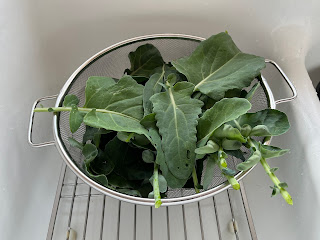Drying foods isn't only for herbs. There's a whole subset on the NCHFP website for how to preserve by drying. It doesn't pose the same inherent risks as canning, but doesn't preserve as long.
Having dried greens of any sort can be a way to sneak veggies into a recipe, like spaghetti sauce or casseroles. You can powder them for smoothies. They can be used in soups, where they pretty much disappear. When you buy "green powder", that's most of what's in there. Dehydrating is also one way to keep greens you bought from going to waste.The procedure is very simple. If you don't have a dehydrator, a convection oven can do it. I set mine to the lowest it will allow, which is 110ºF.
Wash the leaves, then pat them dry with a towel. Remove any thick stems. Spread them out on a lined baking sheet. I had better luck with the parchment one than the Silpat.
Set the trays in the oven and go do other things. After two hours, check the progress. They will have gotten smaller from losing water, so you can rearrange them for best airflow, and rotate trays if necessary. After another hour or two, depending on original moisture content and oven temperature, the leaves should be completely dry and shatter with minimal pressure.Stuff the leaves into a dry container, or powder first if that's how you want to use them. Seal the jar to keep out moisture and store in a cool, dark place. Use within six months for best quality.Difficulty rating π




No comments:
Post a Comment
I got tired of having to moderate all the spam comments and put back the verification. Sorry if it causes hassles.